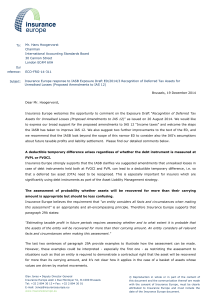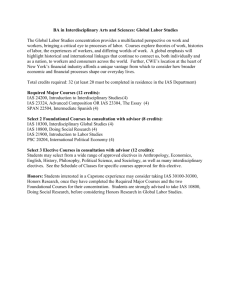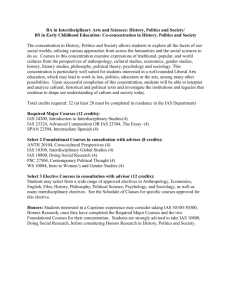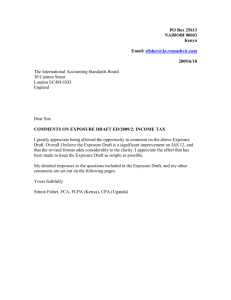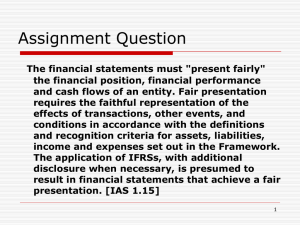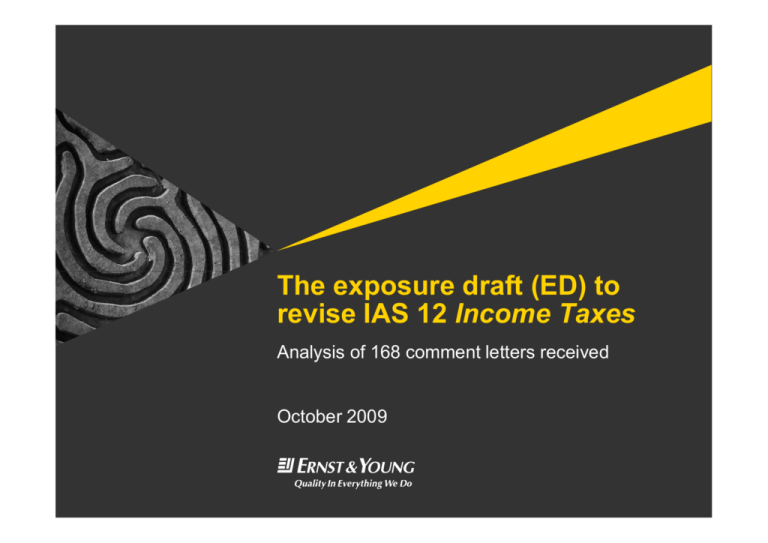
The exposure draft (ED) to
revise IAS 12 Income Taxes
Analysis of 168 comment letters received
October 2009
Background: the road to the exposure draft (ED)
and potential next steps
31
March
2009
Pre-2009
►
IASB works on ED
►
Some joint work
also done with
FASB as a shortterm convergence
project
►
FASB “suspended
deliberations” on
the project in
September 2008
Page 2
►
ED issued
31 July
2009
2010
►
Comment period
ended; 168 letters
received
►
New standard
expected in second
half of 2010?
►
IASB begins review
of comments and is
considering next
steps
►
Effective date?
Analysis of responses to IAS 12 ED
Next steps for the IASB
The ED could be …
► Issued “as is” as a new
International Financial
Reporting Standard (IFRS)
► Amended in response to
comments received and then
issued as a new standard
► Re-issued as a new ED after
major revisions (with a new
comment period)
► Put on hold – pending the work
of a separate income taxes
review project underway
Page 3
►
IASB has stated they will
determine the next course of
action in upcoming board
meetings
Analysis of responses to IAS 12 ED
Key areas of proposed changes
►
►
►
►
►
►
►
Page 4
Definitions of “tax basis” and “temporary difference”
Initial recognition exception
Recognition of deferred tax assets (valuation allowances)
Allocation of tax to components of other comprehensive
income or equity (“backward tracing”)
Uncertain tax positions
Investments in subsidiaries, branches and associates
and interests in joint ventures
Disclosures
Analysis of responses to IAS 12 ED
Analysis of comment letters
Methodology of our analysis
► All 168 comment letters were reviewed
► IASB asked for responses to 18 questions. Ernst & Young categorized
the responses to the 18 questions using a three point scale:
1.
2.
3.
►
►
►
►
Agree
Neutral
Disagree
Most respondents also included a “cover letter” giving their overall
views of the ED and highlighting key areas. We also analysed those
cover letters.
The graphs in the following slides count those that responded to the
particular question. Several entities chose to only respond to some of
the questions (the response rate is shown for each question).
We grouped responses to questions 5 and 6 together (dealing with
valuation allowances proposals), and responses to 13A-D together
(dealing with the proposal to eliminate backward tracing).
The IASB’s questions are condensed and in italics for each question
slide that follows.
Page 5
Analysis of responses to IAS 12 ED
Responses by the numbers …
Type of respondent
Number
Geography of respondent
Number
Companies / entities
77
Europe
87
Standard setters
37
North and South America
25
Accounting firms
6
Asia and Russia
20
Associations / trade groups / others
48
Oceania
16
Total
168
Africa and Middle East
9
Global / not region-specific
11
Total
168
Responses by IFRS usage
Percentage
Top six respondents by country
Number
From countries currently using IFRS
(required or permitted)
80%
UK
35
Germany
15
From countries not currently using
IFRS (including those converting to
IFRS within the next few years)
20%
Canada
14
Australia
11
US
9
Switzerland
8
Page 6
Analysis of responses to IAS 12 ED
Key insights
High-level comments made
► Many asked the IASB not to proceed in issuing a final standard
based on the ED.
► Many questioned whether the ED was a significant enough
improvement to IAS 12 Income Taxes to warrant the cost of
change.
► Many said that the ED was a move to a “rules” approach rather
then a “principles” approach that IFRS are supposed to model.
► Many said the IASB should have changed the objective of the
project to be more focused on improving the clarity of IAS 12
rather than on converging with US GAAP – especially after the
FASB in the US withdrew from the project in 2008.
Page 7
Analysis of responses to IAS 12 ED
Key insights (continued)
High-level comments made
► Three proposals that had the highest level of disagreement from
respondents included those dealing with:
►
►
►
►
General support for what was seen as minor or clarifying changes to
IAS 12 included:
►
►
►
►
New definition of tax base
Methodology for dealing with uncertain tax positions
Elimination of “backward tracing”
Adding valuation allowances to offset deferred tax assets
Clarifying definitions of tax credits and substantively enacted tax rates
Clarifying that the classification of interest and penalties should be an accounting
policy choice
Many decided not to reply to the specific questions (or only to reply to
a few of them) because they were in disagreement overall with the
ED. See the “response rate” of each individual question in the
following slides.
Page 8
Analysis of responses to IAS 12 ED
Q1 – Definitions of tax base and temporary
difference
The exposure draft proposes changes to the definition of tax basis so that the tax basis does not depend on
management’s intentions relating to the recovery or settlement of an asset or liability. It also proposes changes to the
definition of a temporary difference to exclude differences that are not expected to affect taxable profit.
Q1-Definitions of tax basis and temporary difference
Agree
Neutral
31%
0%
Disagree
0%
69%
10%
20%
30%
40%
50%
60%
70%
80%
Question response rate: 75%
Common views expressed:
The new definition is rules-based and conflicts with how many companies use/consume
►
their assets in ongoing business.
►
Taxation based on “sale” is different than that based on “use” in many jurisdictions, which
means a sale-based approach would not lead to an accurate reflection of the deferred tax
consequences, or worse, it could result in an illogical outcome.
►
The flexibility of the current approach was seen as conceptually more appropriate.
Page 9
Analysis of responses to IAS 12 ED
Q2 – Definitions of tax credit and investment tax
credit
The exposure draft introduced definitions of tax credit and investment tax credit.
Q2-Definitions of tax credit and investment tax credit
Agree
Neutral
73%
2%
Disagree
0%
25%
10%
20%
30%
40%
50%
60%
70%
80%
Question response rate: 55%
Common views expressed:
Many welcomed the attempt at clarity, but felt that the IASB should go further by
►
showing some examples of these credits and how they would be accounted for.
►
The ED does not clarify when to use IAS 20 dealing with government grants or IAS 12
for these credits.
Page 10
Analysis of responses to IAS 12 ED
Q3 – Initial recognition exception
The exposure draft proposes eliminating the initial recognition exception in IAS 12. Instead, it introduces proposals for the
initial measurement of assets and liabilities that have tax bases different from their initial carrying amounts.
Q3-Initial recognition exception
Agree
Neutral
29%
1%
Disagree
0%
70%
10%
20%
30%
40%
50%
60%
70%
80%
Question response rate: 70%
Common views expressed:
The proposal adds to complexity and often leads to the same result as current IAS 12.
►
►
Entity-specific tax effects could be hard to determine/understand.
►
The examples are not clear on how the premium or allowance accounts would be
accounted for on an ongoing basis and how they would unwind/reverse.
Page 11
Analysis of responses to IAS 12 ED
Q4 – Investments in subsidiaries, branches,
associates and joint ventures
IAS 12 includes an exception to the temporary difference approach for some investments in subsidiaries, branches,
associates and joint ventures based on whether an entity controls the timing of the reversal of the temporary difference
and the probability of it reversing in the foreseeable future. The exposure draft would replace these requirements with the
requirements in US GAAP …
Q4-Investments in subsidiaries, branches, associates and joint ventures
Agree
Neutral
24%
3%
Disagree
0%
73%
10%
20%
30%
40%
50%
60%
70%
80%
Question response rate: 71%
Common views expressed:
►
The deferred taxes of domestic subsidiaries are often just as hard to determine as
those of foreign subsidiaries – it is not clear why only foreign subsidiaries were given
an exception.
►
Following US GAAP in the proposal does not make sense since the US GAAP
requirements were geared towards the particular workings of US tax law. Also, the
wording in the proposal is not the same as in US GAAP, leading many to question why.
Page 12
Analysis of responses to IAS 12 ED
Q5 and Q6 – Valuation allowances
The exposure draft proposes a change to the approach to the recognition of deferred tax assets. IAS 12 requires a onestep recognition approach of recognising a deferred tax asset to the extent that its realisation is probable. The exposure
draft proposes instead that deferred tax assets should be recognised in full and an offsetting valuation allowance
recognised so that the net carrying amount equals the highest amount that is more likely than not to be realisable against
taxable profit ….
Q5 / Q6-Valuation allow ance
Agree
78%
Neutral
0%
Disagree
0%
22%
10%
20%
30%
40%
50%
60%
70%
80%
90%
Question response rate: 59%
Common views expressed:
Broad agreement with the valuation allowances approach as providing more
►
meaningful information to users of financial statements.
►
Many questioned why the IASB chose “highest amount” that is more likely than not
when describing how valuation allowances offset deferred tax assets. This is different
from US GAAP, and it is unclear why.
Page 13
Analysis of responses to IAS 12 ED
Q7 – Uncertain tax positions
IAS 12 is silent on how to account for uncertainty over whether the tax authority will accept the amounts reported to it. The
exposure draft proposes that current and deferred tax assets and liabilities should be measured at the probabilityweighted average of all possible outcomes, assuming that the tax authority examines the amounts reported to it by the
entity and has full knowledge of all relevant information.
Q7-Uncertain tax positions
Agree
Neutral
12%
0%
Disagree
0%
88%
10%
20%
30%
40%
50%
60%
70%
80%
90%
100%
Question response rate: 83%
Common views expressed:
►
There was broad disagreement that a probability-weighted average approach is valid when
measuring tax uncertainties - many saying it was not reflective of how many taxing systems operate.
►
Many questioned why a “best estimate” is not better than a weighted-average approach.
►
There were broad concerns about disclosures becoming prejudicial in dealing with tax authorities.
►
Many questioned the cost and effort to assess all uncertainties (including “highly certain” deductions)
and not specifying a recognition threshold or a unit of account.
Page 14
Analysis of responses to IAS 12 ED
Q8 – Enacted or substantively enacted rate
IAS 12 requires an entity to measure deferred tax assets and liabilities using the tax rates enacted or substantively
enacted by the reporting date. The exposure draft proposes to clarify that substantive enactment is achieved when future
events required by the enactment process historically have not affected the outcome and are unlikely to do so.
Q8-Enacted or substantively enacted rate
Agree
Neutral
Disagree
0%
89%
1%
10%
10%
20%
30%
40%
50%
60%
70%
80%
90%
100%
Question response rate: 55%
Common views expressed:
Most agreed that the clarification was helpful.
►
►
Some questioned why one tax jurisdiction (the US) needed to be specifically
referenced and suggested the reference should be removed.
Page 15
Analysis of responses to IAS 12 ED
Q9 – Sale rate or use rate
When different rates apply to different ways in which an entity may recover the carrying amount of an asset, IAS 12 requires
deferred tax assets and liabilities to be measured using the rate that is consistent with the expected manner of recovery.
The exposure draft proposes that the rate should be consistent with the deductions that determine the tax basis …
Q9-Sale rate or use rate
Agree
Neutral
36%
1%
Disagree
0%
63%
10%
20%
30%
40%
50%
60%
70%
Question response rate: 59%
Common views expressed:
Most linked their disagreement with their disagreement of the tax basis definition in
►
Q1 – citing the sale rate as arbitrary when the assets are not intended to be sold.
Page 16
Analysis of responses to IAS 12 ED
Q10 – Distributed or undistributed rate
IAS 12 prohibits the recognition of tax effects of distributions before the distribution is recognised. The exposure draft
proposes that the measurement of tax assets and liabilities should include the effect of expected future distributions,
based on the entity’s past practices and expectations of future distributions.
Q10-Distributed or undistributed rate
Agree
Neutral
60%
0%
Disagree
0%
40%
10%
20%
30%
40%
50%
60%
70%
Question response rate: 52%
Common views expressed:
Some questioned why the tax consequences of a future dividend distribution should
►
be recognised when the future dividend distribution itself is not recognised as a
present obligation.
►
Some noted that management intent is present in this proposal – inconsistent with the
IASB’s aim to eliminate management intent as proposed in Q1 on tax basis.
►
Many noted that future distributions would be difficult to accurately determine.
Page 17
Analysis of responses to IAS 12 ED
Q11 – Deductions that do not form part of a tax
basis
An entity may expect to receive tax deductions in the future that do not form part of a tax basis. SFAS 109 gives examples
of ‘special deductions’ available in the US and requires that ‘the tax benefit of special deductions ordinarily is recognized
no earlier than the year in which those special deductions are deductible on the tax return’. SFAS 109 is silent on the
treatment of other deductions that do not form part of a tax basis. IAS 12 is silent on the treatment of tax deductions that
do not form part of a tax basis and the exposure draft proposes no change.
Q11-Deductions that do not form part of a tax basis
Agree
Neutral
84%
3%
Disagree
0%
13%
10%
20%
30%
40%
50%
60%
70%
80%
90%
Question response rate: 49%
Common views expressed:
►
Many supported that the IAS 12 should remain silent on this topic – leaving it up to
entities to decide how to account for these based on principles.
►
Many were unclear what these “special deductions” were and suggested the IASB
provide an example if it wishes them to comment on the question.
►
Some wondered whether the special deductions were tax credits and asked for more
guidance on this issue.
Page 18
Analysis of responses to IAS 12 ED
Q12 – Tax based on two or more systems
In some jurisdictions, an entity may be required to pay tax based on one of two or more tax systems, for example, when
an entity is required to pay the greater of the normal corporate income tax and a minimum amount. The exposure draft
proposes that an entity should consider any interaction between tax systems when measuring deferred tax assets and
liabilities.
Q12-Tax based on tw o or more systems
Agree
Neutral
80%
2%
Disagree
0%
18%
10%
20%
30%
40%
50%
60%
70%
80%
90%
Question response rate: 49%
Common views expressed:
Many viewed this as additional clarity to existing IAS 12 rather than a new rule, and
►
were supportive of it.
►
Some were concerned that the wording of the proposal was not clear enough – citing
for example whether production taxes could be captured by this proposal.
Page 19
Analysis of responses to IAS 12 ED
Q13 – Allocation of tax to components of comprehensive
income and equity (eliminating “backward tracing”)
IAS 12 and SFAS 109 require the tax effects of items recognized outside continuing operations during the current year to be
allocated outside continuing operations. IAS 12 and SFAS 109 differ, however, with respect to the allocation of tax related to
an item that was recognised outside continuing operations in a prior year … IAS 12 requires the allocation of such tax
outside continuing operations, whereas SFAS 109 requires allocation to continuing operations … The exposure draft
proposes adopting the requirements in SFAS 109 on the allocation of tax to components of comprehensive income and
equity.
Q13-Eliminate backw ard tracing
Agree
Neutral
20%
3%
Disagree
0%
77%
10%
20%
30%
40%
50%
60%
70%
80%
90%
Question response rate: 58%
Common views expressed:
►
Most commented that the existing IAS 12 is conceptually superior to the proposal and
did not require changes.
►
Many questioned why the IASB found this an area of such concern and thought that it
was convergence with US GAAP just for the sake of converging.
Page 20
Analysis of responses to IAS 12 ED
Q14 – Allocation of current and deferred taxes
within a group that files a consolidated tax return
IAS 12 is silent on the allocation of income tax to entities within a group that files a consolidated tax return. The exposure
draft proposes that a systematic and rational methodology should be used to allocate the portion of the current and deferred
income tax expense for the consolidated entity to the separate or individual financial statements of the group members.
Q14-Allocation of current and deferred taxes w ithin a group that files a consolidated tax return
Agree
Neutral
85%
2%
Disagree
0%
13%
10%
20%
30%
40%
50%
60%
70%
80%
90%
Question response rate: 52%
Common views expressed:
►
Many viewed this as additional clarity to existing IAS 12 rather than a new rule, and
were supportive of it.
►
Many liked the fact that the IASB did not propose a specific allocation method, rather
suggesting that it should be systematic and rational.
Page 21
Analysis of responses to IAS 12 ED
Q15 - Classification of deferred tax assets and
liabilities
The exposure draft proposes the classification of deferred tax assets and liabilities as current or non-current, based on the
financial statement classification of the related non-tax asset or liability.
Q15-Classification of deferred tax assets and liabilities
Agree
Neutral
36%
1%
Disagree
0%
63%
10%
20%
30%
40%
50%
60%
70%
Question response rate: 64%
Common views expressed:
Many felt it was very difficult to classify deferred taxes as current or non-current and
►
questioned the cost-benefit of doing so.
►
Many pointed out that the timing of when a temporary difference reverses may not be
the same as the related current or non-current asset or liability it relates to, leading to
difficulty in applying the results of the proposal.
Page 22
Analysis of responses to IAS 12 ED
Q16 – Classification of interest and penalties
IAS 12 is silent on the classification of interest and penalties. The exposure draft proposes that the classification of
interest and penalties should be a matter of accounting policy choice to be applied consistently and that the policy chosen
should be disclosed.
Q16-Classification of interest and penalties
Agree
Neutral
84%
1%
Disagree
0%
15%
10%
20%
30%
40%
50%
60%
70%
80%
90%
Question response rate: 57%
Common views expressed:
Many agreed that this should be an accounting policy choice and applied consistently
►
instead of the IASB proposing a rule and suggesting one method over another.
Page 23
Analysis of responses to IAS 12 ED
Q17 – Disclosures
The exposure draft proposes additional disclosures to make financial statements more informative.
Q17-Disclosures
Agree
Neutral
46%
0%
Disagree
0%
54%
10%
20%
30%
40%
50%
60%
Question response rate: 67%
Common views expressed:
Many questioned the usefulness of the additional disclosures to users of financial
►
statements.
►
Many also re-commented on the uncertain tax position disclosures as an area of
concern – similar to their responses to Q7.
Page 24
Analysis of responses to IAS 12 ED
Q18 – Effective date and transition
Paragraphs 50–52 of the exposure draft set out the proposed transition for entities that use IFRS, and paragraph C2 sets
out the proposed transition for first-time adopters.
Q18-Effective date and transition
Agree
Neutral
81%
1%
Disagree
0%
18%
10%
20%
30%
40%
50%
60%
70%
80%
90%
Question response rate: 51%
Common views expressed:
Many agreed with the IASB’s transition proposals, although they commented that it
►
may be a moot point given their overall disagreement with the ED itself.
►
Some questioned the clarity of the wording of the transition proposals.
Page 25
Analysis of responses to IAS 12 ED
About Ernst & Young
Ernst & Young
Assurance | Tax | Transactions | Advisory
About Ernst & Young
Ernst & Young is a global leader in assurance, tax, transaction and
advisory services. Worldwide, our 144,000 people are united by our
shared values and an unwavering commitment to quality. We make a
difference by helping our people, our clients and our wider
communities achieve potential.
For more information, please visit www.ey.com
Ernst & Young refers to the global organisation of member firms of
Ernst & Young Global Limited, each of which is a separate legal
entity. Ernst & Young Global Limited, a UK company limited by
guarantee, does not provides services to clients.
© 2009 EYGM Limited
All Rights Reserved
EYG SCORE No. DL0158
Page 26
Analysis of responses to IAS 12 ED


